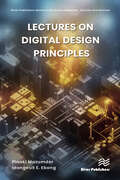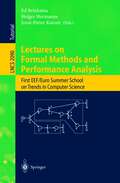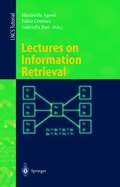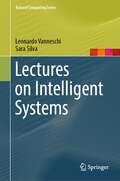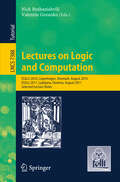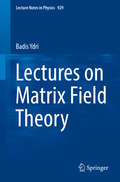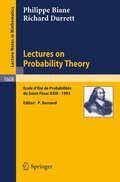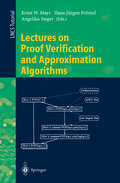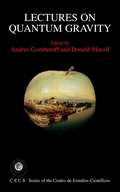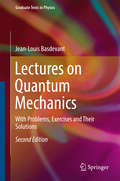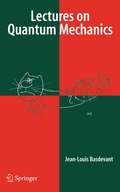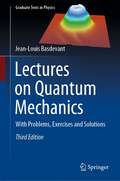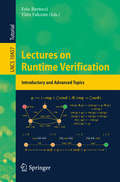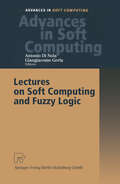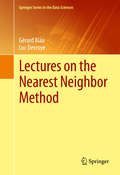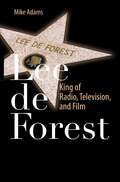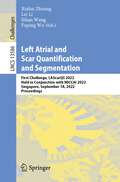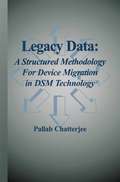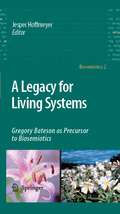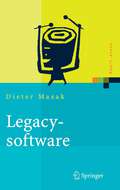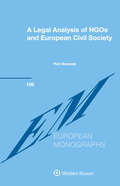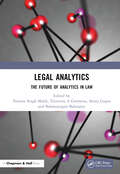- Table View
- List View
Lectures on Digital Design Principles (River Publishers Series in Electronic Materials, Circuits and Devices)
by Pinaki Mazumder Idongesit E. EbongLectures on Digital Design Principles provides students an accessible reference for engaging with the building blocks of digital logic design. The book is an aggregation of lectures for an introductory course and provides a conversational style to better engage with students. Since the text is developed from lectures, important and foundational concepts are highlighted without tedious proofs. With respect to subject matter, students are introduced to different methods of abstracting digital systems, along with the strengths and weaknesses of these different methods. For example, Boolean logic can be represented as algebraic equations, gate level diagrams, switching circuits, truth tables, etc. Strengths and drawbacks to these representations are discussed in the context of Boolean minimization and electronic design automation. The text also delves into dynamic behavior of digital circuits with respect to timing in combinational circuits and state transitions in sequential circuits.
Lectures on Digital Design Principles (River Publishers Series in Electronic Materials, Circuits and Devices)
by Pinaki Mazumder Idongesit E. EbongLectures on Digital Design Principles provides students an accessible reference for engaging with the building blocks of digital logic design. The book is an aggregation of lectures for an introductory course and provides a conversational style to better engage with students. Since the text is developed from lectures, important and foundational concepts are highlighted without tedious proofs. With respect to subject matter, students are introduced to different methods of abstracting digital systems, along with the strengths and weaknesses of these different methods. For example, Boolean logic can be represented as algebraic equations, gate level diagrams, switching circuits, truth tables, etc. Strengths and drawbacks to these representations are discussed in the context of Boolean minimization and electronic design automation. The text also delves into dynamic behavior of digital circuits with respect to timing in combinational circuits and state transitions in sequential circuits.
Lectures on Formal Methods and Performance Analysis: First EEF/Euro Summer School on Trends in Computer Science Berg en Dal, The Netherlands, July 3-7, 2000. Revised Lectures (Lecture Notes in Computer Science #2090)
by Ed Brinksma Holger Hermanns Joost-Pieter KatoenTraditionally, models and methods for the analysis of the functional correctness of reactive systems, and those for the analysis of their performance (and - pendability) aspects, have been studied by di?erent research communities. This has resulted in the development of successful, but distinct and largely unrelated modeling and analysis techniques for both domains. In many modern systems, however, the di?erence between their functional features and their performance properties has become blurred, as relevant functionalities become inextricably linked to performance aspects, e.g. isochronous data transfer for live video tra- mission. During the last decade, this trend has motivated an increased interest in c- bining insights and results from the ?eld of formal methods – traditionally - cused on functionality – with techniques for performance modeling and analysis. Prominent examples of this cross-fertilization are extensions of process algebra and Petri nets that allow for the automatic generation of performance models, the use of formal proof techniques to assess the correctness of randomized - gorithms, and extensions of model checking techniques to analyze performance requirements automatically. We believe that these developments markthe - ginning of a new paradigm for the modeling and analysis of systems in which qualitative and quantitative aspects are studied from an integrated perspective. We are convinced that the further worktowards the realization of this goal will be a growing source of inspiration and progress for both communities.
Lectures on Information Retrieval: Third European Summer-School, ESSIR 2000 Varenna, Italy, September 11-15, 2000. Revised Lectures (Lecture Notes in Computer Science #1980)
by Maristella Agosti Fabio Crestani Gabriella PasiInformation Retrieval (IR) is concerned with the effective and efficient retrieval of information based on its semantic content. The central problem in IR is the quest to find the set of relevant documents, among a large collection containing the information sought, satisfying a user's information need usually expressed in a natural language query. Documents may be objects or items in any medium: text, image, audio, or indeed a mixture of all three. This book presents 12 revised lectures given at the Third European Summer School in Information Retrieval, ESSIR 2000, held at the Villa Monastero, Varenna, Italy, in September 2000. The first part of the book is devoted to the foundation of IR and related areas; the second part on advanced topics addresses various current issues, from usability aspects to Web searching and browsing.
Lectures on Intelligent Systems (Natural Computing Series)
by Leonardo Vanneschi Sara SilvaThis textbook provides the reader with an essential understanding of computational methods for intelligent systems. These are defined as systems that can solve problems autonomously, in particular problems where algorithmic solutions are inconceivable for humans or not practically executable by computers. Despite the rapidly growing applications in this field, the book avoids application details, instead focusing on computational methods that equip the reader with the methodological tools and competencies necessary to tackle current and future complex applications. The book consists of two parts: computational intelligence methods for optimization, and machine learning. Part I begins with the concept of optimization, and introduces local search algorithms, genetic algorithms, and particle swarm optimization. Part II begins with an introduction to machine learning and covers several methods, many of which can be used as supervised learning algorithms, such as decision tree learning, artificial neural networks, genetic programming, Bayesian learning, support vector machines, and ensemble methods, plus a discussion of unsupervised learning. This textbook is written in a self-contained style, suitable for undergraduate or graduate students in computer science and engineering, and for self-study by researchers and practitioners.
Lectures on Logic and Computation: ESSLLI 2010, Copenhagen, Denmark, August 2010, ESSLLI 2011, Ljubljana, Slovenia, August 2011, Selected Lecture Notes (Lecture Notes in Computer Science #7388)
by Nick Bezhanishvili Valentin GorankoThe European Summer School in Logic, Language and Information (ESSLLI) is organized every year by the Association for Logic, Language and Information (FoLLI) in different sites around Europe. The main focus of ESSLLI is on the interface between linguistics, logic and computation. ESSLLI offers foundational, introductory and advanced courses, as well as workshops, covering a wide variety of topics within the three areas of interest: Language and Computation, Language and Logic, and Logic and Computation. During two weeks, around 50 courses and 10 workshops are offered to the attendants, each of 1.5 hours per day during a five days week, with up to seven parallel sessions. ESSLLI also includes a student session (papers and posters by students only, 1.5 hour per day during the two weeks) and four evening lectures by senior scientists in the covered areas. The 6 course notes were carefully reviewed and selected. The papers are organized in topical sections on computational complexity, multi-agant systems, natural language processing, strategies in games and formal semantics.
Lectures on Matrix Field Theory (Lecture Notes in Physics #929)
by Badis YdriThese lecture notes provide a systematic introduction to matrix models of quantum field theories with non-commutative and fuzzy geometries. The book initially focuses on the matrix formulation of non-commutative and fuzzy spaces, followed by a description of the non-perturbative treatment of the corresponding field theories. As an example, the phase structure of non-commutative phi-four theory is treated in great detail, with a separate chapter on the multitrace approach. The last chapter offers a general introduction to non-commutative gauge theories, while two appendices round out the text. Primarily written as a self-study guide for postgraduate students – with the aim of pedagogically introducing them to key analytical and numerical tools, as well as useful physical models in applications – these lecture notes will also benefit experienced researchers by providing a reference guide to the fundamentals of non-commutative field theory with an emphasis on matrix models and fuzzy geometries.
Lectures on Probability Theory: Ecole d'Ete de Probabilites de Saint-Flour XXIII - 1993 (Lecture Notes in Mathematics #1608)
by Philippe Biane Richard DurrettThis book contains two of the three lectures given at the Saint-Flour Summer School of Probability Theory during the period August 18 to September 4, 1993.
Lectures on Proof Verification and Approximation Algorithms (Lecture Notes in Computer Science #1367)
by Ernst W. Mayr Hans Jürgen Prömel Angelika StegerDuring the last few years, we have seen quite spectacular progress in the area of approximation algorithms: for several fundamental optimization problems we now actually know matching upper and lower bounds for their approximability. This textbook-like tutorial is a coherent and essentially self-contained presentation of the enormous recent progress facilitated by the interplay between the theory of probabilistically checkable proofs and aproximation algorithms. The basic concepts, methods, and results are presented in a unified way to provide a smooth introduction for newcomers. These lectures are particularly useful for advanced courses or reading groups on the topic.
Lectures on Quantum Gravity (Series of the Centro De Estudios Científicos)
by Donald Marolf Andrés GomberoffThe 2002 Pan-American Advanced Studies Institute School on Quantum Gravity was held at the Centro de Estudios Cientificos (CECS),Valdivia, Chile, January 4-14, 2002. The school featured lectures by ten speakers, and was attended by nearly 70 students from over 14 countries. A primary goal was to foster interaction and communication between participants from different cultures, both in the layman’s sense of the term and in terms of approaches to quantum gravity. We hope that the links formed by students and the school will persist throughout their professional lives, continuing to promote interaction and the essential exchange of ideas that drives research forward. This volume contains improved and updated versions of the lectures given at the School. It has been prepared both as a reminder for the participants, and so that these pedagogical introductions can be made available to others who were unable to attend. We expect them to serve students of all ages well.
Lectures on Quantum Mechanics: With Problems, Exercises and their Solutions (Graduate Texts in Physics)
by Jean-Louis BasdevantBeautifully illustrated and engagingly written, Twelve Lectures in Quantum Mechanics presents theoretical physics with a breathtaking array of examples and anecdotes. Basdevant’s style is clear and stimulating, in the manner of a brisk lecture that can be followed with ease and enjoyment. Here is a sample of the book’s style, from the opening of Chapter 1: "If one were to ask a passer-by to quote a great formula of physics, chances are that the answer would be ‘E = mc2’…. There is no way around it: all physics is quantum, from elementary particles, to stellar physics and the Big Bang, not to mention semiconductors and solar cells."
Lectures on Quantum Mechanics
by Jean-Louis BasdevantBeautifully illustrated and engagingly written, Twelve Lectures in Quantum Mechanics presents theoretical physics with a breathtaking array of examples and anecdotes. Basdevant’s style is clear and stimulating, in the manner of a brisk lecture that can be followed with ease and enjoyment. Here is a sample of the book’s style, from the opening of Chapter 1: "If one were to ask a passer-by to quote a great formula of physics, chances are that the answer would be ‘E = mc2’…. There is no way around it: all physics is quantum, from elementary particles, to stellar physics and the Big Bang, not to mention semiconductors and solar cells."
Lectures on Quantum Mechanics: With Problems, Exercises and Solutions (Graduate Texts in Physics)
by Jean-Louis BasdevantBeautifully illustrated and engagingly written, Twelve Lectures in Quantum Mechanics presents theoretical physics with a breathtaking array of examples and anecdotes. Basdevant’s style is clear and stimulating, in the manner of a brisk lecture that can be followed with ease and enjoyment. Here is a sample of the book’s style, from the opening of Chapter 1: "If one were to ask a passer-by to quote a great formula of physics, chances are that the answer would be ‘E = mc2’…. There is no way around it: all physics is quantum, from elementary particles, to stellar physics and the Big Bang, not to mention semiconductors and solar cells."
Lectures on Runtime Verification: Introductory and Advanced Topics (Lecture Notes in Computer Science #10457)
by Ezio Bartocci Yliès FalconeThe idea of this volume originated from the need to have a book for students to support their training with several tutorials on different aspects of RV. The volume has been organized into seven chapters and the topics covered include an introduction on runtime verification, dynamic analysis of concurrency errors, monitoring events that carry data, runtime error reaction and prevention, monitoring of cyber-physical systems, runtime verification for decentralized and distributed systems and an industrial application of runtime verification techniques in financial transaction systems.
Lectures on Soft Computing and Fuzzy Logic (Advances in Intelligent and Soft Computing #11)
by Antonio Di Nola Giangiacomo GerlaThe present volume collects selected papers arising from lectures delivered by the authors at the School on Fuzzy Logic and Soft Computing held during the years 1996/97/98/99 and sponsored by the Salerno University. The authors contributing to this volume agreed with editors to write down, to enlarge and, in many cases, to rethink their original lectures, in order to offer to readership, a more compact presentation of the proposed topics. The aim of the volume is to offer a picture, as a job in progress, of the effort that is coming in founding and developing soft computing's techniques. The volume contains papers aimed to report on recent results containing genuinely logical aspects of fuzzy logic. The topics treated in this area cover algebraic aspects of Lukasiewicz Logic, Fuzzy Logic as the logic of continuous t-norms, Intuitionistic Fuzzy Logic. Aspects of fuzzy logic based on similar ity relation are presented in connection with the problem of flexible querying in deductive database. Departing from fuzzy logic, some papers present re sults in Probability Logic treating computational aspects, results based on indishernability relation and a non commutative version of generalized effect algebras. Several strict applications of soft computing are presented in the book. Indeed we find applications ranging among pattern recognition, image and signal processing, evolutionary agents, fuzzy cellular networks, classi fication in fuzzy environments. The volume is then intended to serve as a reference work for foundational logico-algebraic aspect of Soft Computing and for concrete applications of soft computing technologies.
Lectures on the Nearest Neighbor Method (Springer Series in the Data Sciences)
by Gérard Biau Luc DevroyeThis text presents a wide-ranging and rigorous overview of nearest neighbor methods, one of the most important paradigms in machine learning. Now in one self-contained volume, this book systematically covers key statistical, probabilistic, combinatorial and geometric ideas for understanding, analyzing and developing nearest neighbor methods. Gérard Biau is a professor at Université Pierre et Marie Curie (Paris). Luc Devroye is a professor at the School of Computer Science at McGill University (Montreal).
Led by Donkeys: How four friends with a ladder took on Brexit
by LedByDonkeys Ben Stewart James Sadri Oliver KnowlesThe official account - complete with full-colour illustrations - of how four ordinary people managed to expose the government's hypocrisies through a nationwide guerrilla advertising campaign.Seeking to highlight the hypocrisy of our politicians on Brexit four friends armed with nothing more than ladders, roller brushes and a treasure trove of damning statements from our leaders slapped up the politicians' biggest lies on billboards around the country.This guerrilla operation wasn't easy, but it wasn't long before the British public enabled them to take things into their own hands - and the rest is history. Leave the EU or remain? An apparently simple question divided the nation in historic fashion. Many of us believed the words of these politicians. By putting up their quotes as billboards, self-styled 'Led By Donkeys' had clear intentions - to compare the promises that have been made across the years with the damning reality.
Lee de Forest: King of Radio, Television, and Film
by Mike AdamsThe life-long inventor, Lee de Forest invented the three-element vacuum tube used between 1906 and 1916 as a detector, amplifier, and oscillator of radio waves. Beginning in 1918 he began to develop a light valve, a device for writing and reading sound using light patterns. While he received many patents for his process, he was initially ignored by the film industry. In order to promote and demonstrate his process he made several hundred sound short films, he rented space for their showing; he sold the tickets and did the publicity to gain audiences for his invention. Lee de Forest officially brought sound to film in 1919. Lee De Forest: King of Radio, Television, and Film is about both invention and early film making; de Forest as the scientist and producer, director, and writer of the content. This book tells the story of de Forest’s contribution in changing the history of film through the incorporation of sound. The text includes primary source historical material, U.S. patents and richly-illustrated photos of Lee de Forest’s experiments. Readers will greatly benefit from an understanding of the transition from silent to audio motion pictures, the impact this had on the scientific community and the popular culture, as well as the economics of the entertainment industry.
Left Atrial and Scar Quantification and Segmentation: First Challenge, LAScarQS 2022, Held in Conjunction with MICCAI 2022, Singapore, September 18, 2022, Proceedings (Lecture Notes in Computer Science #13586)
by Xiahai Zhuang Lei Li Sihan Wang Fuping WuThis book constitutes the First Left Atrial and Scar Quantification and Segmentation Challenge, LAScarQS 2022, which was held in conjunction with the 25th International Conference on Medical Image Computing and Computer-Assisted Intervention, MICCAI 2022, in Singapore, in September 2022.The 15 papers presented in this volume were carefully reviewed and selected form numerous submissions. The aim of the challenge is not only benchmarking various LA scar segmentation algorithms, but also covering the topic of general cardiac image segmentation, quantification, joint optimization, and model generalization, and raising discussions for further technical development and clinical deployment.
Legacy Data: A Structured Methodology For Device Migration In Dsm Technology
by Pallab ChatterjeeThis unique book deals with the migration of existing hard IP from one technology to another, using repeatable procedures. It will allow CAD practitioners to quickly develop methodologies that capitalize on the large volumes of legacy data available within a company today.
A Legacy for Living Systems: Gregory Bateson as Precursor to Biosemiotics (Biosemiotics #2)
by Jesper HoffmeyerGregory Bateson’s contribution to 20th century thinking has appealed to scholars from a wide range of fields dealing in one way or another with aspects of communication and epistemology. A number of his insights were taken up and developed further in anthropology, psychology, evolutionary biology and communication theory. But the large, trans-disciplinary synthesis that, in his own mind, was his major contribution to science received little attention from the mainstream scientific communities. This book represents a major attempt to revise this deficiency. Scholars from ecology, biochemistry, evolutionary biology, cognitive science, anthropology and philosophy discuss how Bateson's thinking might lead to a fruitful reframing of central problems in modern science. Most important perhaps, Bateson's bioanthropology is shown to play a key role in developing the set of ideas explored in the new field of biosemiotics. The idea that organismic life is indeed basically semiotic or communicative lies at the heart of the biosemiotic approach to the study of life. The only book of its kind, this volume provides a key resource for the quickly-growing substratum of scholars in the biosciences, philosophy and medicine who are seeking an elegant new approach to exploring highly complex systems.
Legacysoftware: Das lange Leben der Altsysteme (Xpert.press)
by Dieter MasakDie Software heutiger Unternehmen besteht zum größten Teil aus Altsystemen, die zwischen fünf und dreißig Jahren alt sein können. In der heutigen Softwareliteratur wird vorwiegend die Schaffung und Konzeption von neuen Systemen behandelt. Ziel dieses Buches ist es dagegen, eine Darstellung der Entwicklungsmöglichkeiten und Strategien für die Altsysteme aufzuzeigen. Dabei beschäftigt sich der Autor auch mit folgenden Fragen: Wie kann die Wartung besser werden? Muss man wirklich ablösen? Wie funktioniert der Ersatz durch Standardsoftware?
A Legal Analysis of NGOs and European Civil Society
by Piotr StaszczykAmid widespread awareness and discussion of "the democratic deficit" and "shrinking civil space," the role of nongovernmental organizations (NGOs) becomes increasingly important. Yet the precise legal status of such bodies is ill-defined. Here, for the first time, is a thorough commentary and analysis of the position of NGOs and European civil society in the European Union (EU) constitutional system, bringing to the fore existing and desirable means of public participation in EU lawmaking. Recognizing that NGOs have historically been designed to meet the ends of civil society, the analysis focuses on the following topics and issues: means in EU law of advocating for the collective interests of civil society; unofficial means of influencing the EU institutions; access to documents and the European Citizens’ Initiative as means of exerting pressure on EU legislation; relations between the EU institutions and NGOs, including lobbying activities; bringing actions in the common good before courts and other institutions; the special role of NGOs in environmental protection; complaints to the Commission and the European Ombudsman; EU funding for NGOs; and transboundary philanthropy. Drawing on a broad spectrum of sources of law, including CJEU case law and relevant legal literature, the book offers insightful proposals leading to the democratization of the EU’s internal procedures that will allow enhanced cooperation of civil society representatives across national borders. In its thorough examination of legal tools that can respond to the "democratic deficit," this book makes a distinctive contribution to the public debate on the future of the European Union, especially in the context of emerging threats to further integration. It will prove of great value not only to civil activists, academics and policymakers but also to everyone interested in European integration and affordance for social participation.
Legal Analytics: The Future of Analytics in Law
by Namita Singh Malik Elizaveta A Gromova Smita Gupta Balamurugan BalusamyLegal Analytics: The Future of Analytics in Law navigates the crisscrossing of intelligent technology and legal field in building up new landscape of transformation. Legal automation navigation is multidimensional wherein it intends to construct streamline communication, approval and management of legal task. Evolving environment of technology has emphasized need for better automations in legal field from time to time. Although legal scholars took long to embrace Information revolution of legal field. •Describes the historical development of law and automation •Analyses the challenges and opportunities in law and automation •Studies the current research and development in the convergence of Law, Artificial Intelligence and Legal Analytics •Explores the recent emerging trends and technologies that are used by various legal System globally for Crime Prediction & Prevention •Examines the applicability of legal analytics in forensic investigation •Investigates the impact of legal analytics tools and techniques in judicial decision making •Analyses deep learning techniques and its scope in accelerating legal analytics in developed and developing countries • Provides the in-depth analysis of implementation, challenges and issues in the society related to legal analytics The book is primarily aimed at graduates, postgraduates in law & technology, computer science and information technology. Legal practitioners and academicians will also find this book helpful.
Legal Analytics: The Future of Analytics in Law
by Namita Singh Malik, Elizaveta A Gromova, Smita Gupta and Balamurugan BalusamyLegal Analytics: The Future of Analytics in Law navigates the crisscrossing of intelligent technology and legal field in building up new landscape of transformation. Legal automation navigation is multidimensional wherein it intends to construct streamline communication, approval and management of legal task. Evolving environment of technology has emphasized need for better automations in legal field from time to time. Although legal scholars took long to embrace Information revolution of legal field. •Describes the historical development of law and automation •Analyses the challenges and opportunities in law and automation •Studies the current research and development in the convergence of Law, Artificial Intelligence and Legal Analytics •Explores the recent emerging trends and technologies that are used by various legal System globally for Crime Prediction & Prevention •Examines the applicability of legal analytics in forensic investigation •Investigates the impact of legal analytics tools and techniques in judicial decision making •Analyses deep learning techniques and its scope in accelerating legal analytics in developed and developing countries • Provides the in-depth analysis of implementation, challenges and issues in the society related to legal analytics The book is primarily aimed at graduates, postgraduates in law & technology, computer science and information technology. Legal practitioners and academicians will also find this book helpful.
